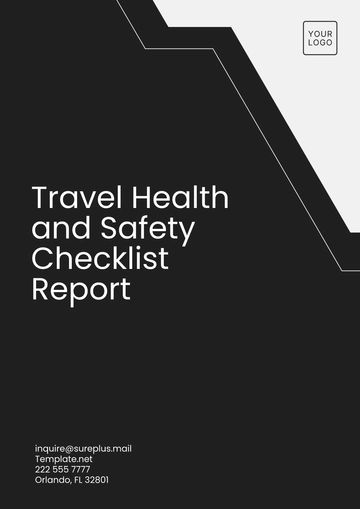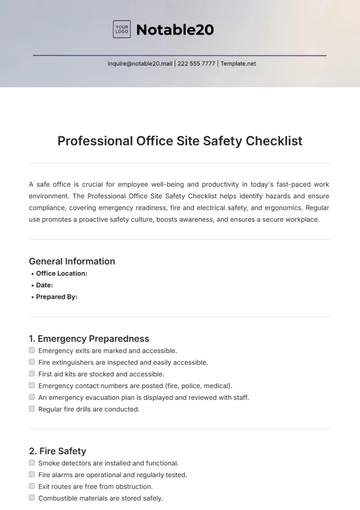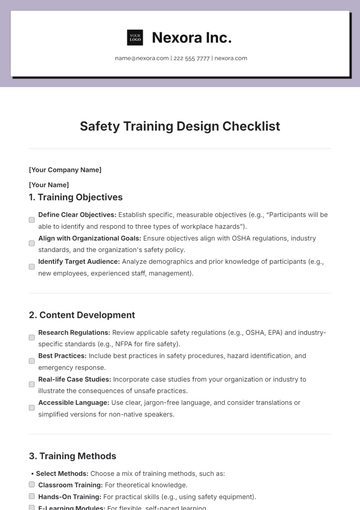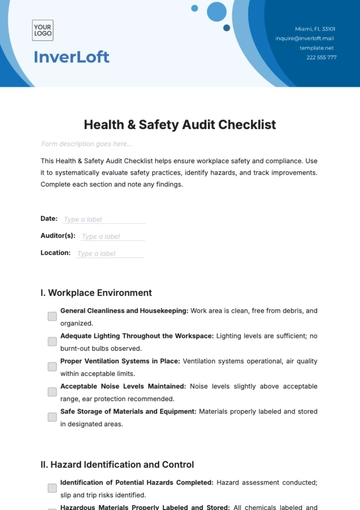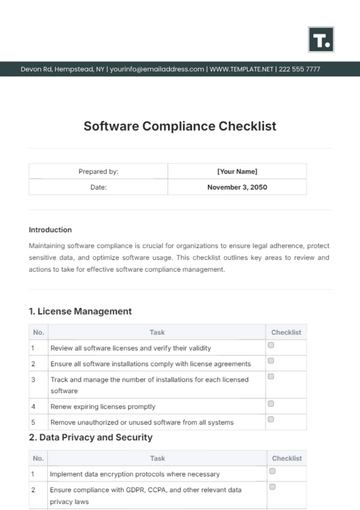Free Health and Safety Inspection Checklist Report

Prepared by: [Your Name]
Company: [Your Company Name]
Date: May 1, 2060
1. Introduction
This report presents a comprehensive assessment of the health and safety standards within the organization. The purpose of this inspection is to evaluate compliance with legal health and safety regulations, assess workplace risks, and ensure that measures are in place to protect the well-being of all employees. A proactive approach to health and safety helps prevent accidents, promotes a culture of safety, and fosters a positive work environment.
2. Objectives
The key objectives of this health and safety inspection include:
Identifying potential risks and hazards: Recognizing any current or future risks that could affect employees' health or safety.
Ensuring compliance with health and safety regulations: Verifying that the organization adheres to local and national safety laws.
Promoting a safe work environment: Creating an environment that prioritizes employee well-being.
Recommending corrective actions: Suggesting improvements or interventions for areas that do not meet safety standards.
3. Inspection Process
3.1. Preparation
In advance of the inspection, the following steps were undertaken to ensure a thorough and effective evaluation:
Review of previous inspection reports: This helped identify previously noted hazards and track the resolution of past issues.
Preparation of inspection tools and equipment: Ensuring all necessary tools for the inspection, such as checklists, cameras, and safety equipment, are available.
Notification of relevant stakeholders: Department heads and managers were informed about the inspection schedule to ensure their cooperation.
3.2. Inspection Areas
The inspection process focused on the following critical areas within the organization to assess health and safety:
Office spaces: To identify ergonomic risks and ensure a healthy working environment.
Warehouse and storage areas: Ensuring compliance with safety standards regarding storage, handling, and accessibility.
Production floors: Focusing on machine safety, proper ventilation, and accident prevention measures.
Maintenance workshops: Evaluating tools, machinery, and safe operation procedures.
Restrooms and kitchen areas: To verify cleanliness and hygienic standards, as well as ensure that equipment is functioning properly.
4. Inspection Criteria
The health and safety inspection was conducted based on the following detailed criteria:
Category | Criteria | Compliance Status |
|---|---|---|
Fire Safety | Accessible fire exits and extinguishers |
|
Electrical Safety | No exposed wires, functional circuit breakers |
|
Ergonomics | Proper seating and desk arrangements |
|
Chemical Safety | Proper labeling, storage, and handling of chemicals |
|
Personal Protective Equipment (PPE) | Availability and proper use of PPE (gloves, helmets, goggles, etc.) |
|
First Aid | Accessible first aid kits and trained personnel |
|
Ventilation | Proper ventilation in enclosed spaces |
|
Workplace Hygiene | Cleanliness and waste management systems |
|
5. Findings
The following key observations were made during the inspection:
Fire Safety: Fire extinguishers are easily accessible; however, some require maintenance checks to ensure functionality.
Electrical Safety: All electrical panels are in good condition, and no exposed wires were found. Circuit breakers are functioning as required.
Ergonomics: Several office workstations fail to meet ergonomic guidelines, which may result in long-term discomfort or injury for employees.
Chemical Safety: The labeling of chemicals in storage areas is inadequate, which could cause confusion and increase the risk of mishandling.
PPE: PPE is available in all necessary areas, but some employees were observed not wearing appropriate protective gear during certain tasks.
First Aid: First aid kits are available in key locations; however, some items were outdated and need replenishment.
Ventilation: Production and warehouse areas have adequate ventilation, but some maintenance workshops were found to have insufficient airflow, which could pose long-term health risks.
Workplace Hygiene: Office and common areas are generally clean, though there are areas in the kitchen and restrooms where cleaning protocols were not followed.
6. Recommendations
Based on the findings, the following corrective actions are recommended:
Fire Safety:
Schedule immediate maintenance for fire extinguishers that are overdue for checks.
Ensure fire exits are marked and unobstructed at all times.
Ergonomics:
Conduct ergonomic assessments for all workstations and provide adjustable desks and chairs where necessary.
Offer training sessions for employees on proper ergonomics and posture.
Chemical Safety:
Improve labeling and categorization in chemical storage areas to make identification easier and reduce the risk of accidents.
Provide staff with proper handling training for hazardous chemicals.
PPE:
Reinforce the importance of wearing personal protective equipment and conduct regular PPE training sessions.
Ensure that all employees have access to the appropriate protective gear for their tasks.
First Aid:
Replace outdated supplies in first aid kits and ensure all staff are trained in basic first aid and CPR.
Ventilation:
Address ventilation issues in maintenance workshops by installing additional fans or air circulation systems.
Workplace Hygiene:
Ensure regular cleaning schedules are followed, particularly in the kitchen and restroom areas.
Conduct hygiene awareness campaigns to promote cleanliness among employees.
7. Conclusion
This health and safety inspection has successfully identified key areas for improvement within the organization. By addressing the recommendations made in this report, the organization can mitigate potential health and safety risks, ensure compliance with legal requirements, and maintain a safe and productive work environment for all employees. Regular follow-up inspections should be conducted to ensure continuous compliance and to foster a culture of safety within the organization.
- 100% Customizable, free editor
- Access 1 Million+ Templates, photo’s & graphics
- Download or share as a template
- Click and replace photos, graphics, text, backgrounds
- Resize, crop, AI write & more
- Access advanced editor
Ensure workplace safety with the Health and Safety Inspection Checklist Report Template from Template.net. This fully editable and customizable template allows you to tailor it to your specific needs. Easily make adjustments with our Ai Editor Tool, providing a seamless experience to create professional, comprehensive inspection reports that promote a safe working environment.
You may also like
- Cleaning Checklist
- Daily Checklist
- Travel Checklist
- Self Care Checklist
- Risk Assessment Checklist
- Onboarding Checklist
- Quality Checklist
- Compliance Checklist
- Audit Checklist
- Registry Checklist
- HR Checklist
- Restaurant Checklist
- Checklist Layout
- Creative Checklist
- Sales Checklist
- Construction Checklist
- Task Checklist
- Professional Checklist
- Hotel Checklist
- Employee Checklist
- Moving Checklist
- Marketing Checklist
- Accounting Checklist
- Camping Checklist
- Packing Checklist
- Real Estate Checklist
- Cleaning Checklist Service
- New Employee Checklist
- Food Checklist
- Home Inspection Checklist
- Advertising Checklist
- Event Checklist
- SEO Checklist
- Assessment Checklist
- Inspection Checklist
- Baby Registry Checklist
- Induction Checklist
- Employee Training Checklist
- Medical Checklist
- Safety Checklist
- Site Checklist
- Job Checklist
- Service Checklist
- Nanny Checklist
- Building Checklist
- Work Checklist
- Office Checklist
- Training Checklist
- Website Checklist
- IT and Software Checklist
- Performance Checklist
- Project Checklist
- Startup Checklist
- Education Checklist
- Home Checklist
- School Checklist
- Maintenance Checklist
- Planning Checklist
- Manager Checklist
- Wedding Checklist
- Vehicle Checklist
- Travel Agency Checklist
- Vehicle Inspection Checklist
- Interior Design Checklist
- Backpacking Checklist
- Business Checklist
- Legal Checklist
- Nursing Home Checklist
- Weekly Checklist
- Recruitment Checklist
- Salon Checklist
- Baby Checklist
- Equipment Checklist
- Trade Show Checklist
- Party Checklist
- Hospital Bag Checklist
- Evaluation Checklist
- Agency Checklist
- First Apartment Checklist
- Hiring Checklist
- Opening Checklist
- Small Business Checklist
- Rental Checklist
- College Dorm Checklist
- New Puppy Checklist
- University Checklist
- Building Maintenance Checklist
- Work From Home Checklist
- Student Checklist
- Application Checklist




